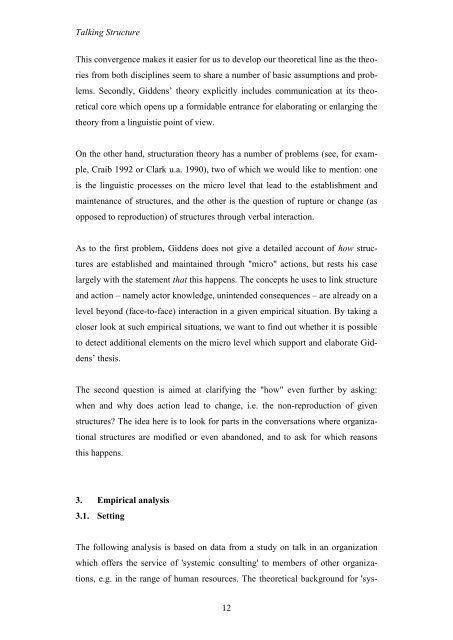In organisation theory, bridging the gap between „micro“ and „macro ...
In organisation theory, bridging the gap between „micro“ and „macro ...
In organisation theory, bridging the gap between „micro“ and „macro ...
You also want an ePaper? Increase the reach of your titles
YUMPU automatically turns print PDFs into web optimized ePapers that Google loves.
Talking Structure<br />
This convergence makes it easier for us to develop our <strong>the</strong>oretical line as <strong>the</strong> <strong>the</strong>o-<br />
ries from both disciplines seem to share a number of basic assumptions <strong>and</strong> prob-<br />
lems. Secondly, Giddens’ <strong><strong>the</strong>ory</strong> explicitly includes communication at its <strong>the</strong>o-<br />
retical core which opens up a formidable entrance for elaborating or enlarging <strong>the</strong><br />
<strong><strong>the</strong>ory</strong> from a linguistic point of view.<br />
On <strong>the</strong> o<strong>the</strong>r h<strong>and</strong>, structuration <strong><strong>the</strong>ory</strong> has a number of problems (see, for exam-<br />
ple, Craib 1992 or Clark u.a. 1990), two of which we would like to mention: one<br />
is <strong>the</strong> linguistic processes on <strong>the</strong> micro level that lead to <strong>the</strong> establishment <strong>and</strong><br />
maintenance of structures, <strong>and</strong> <strong>the</strong> o<strong>the</strong>r is <strong>the</strong> question of rupture or change (as<br />
opposed to reproduction) of structures through verbal interaction.<br />
As to <strong>the</strong> first problem, Giddens does not give a detailed account of how struc-<br />
tures are established <strong>and</strong> maintained through "micro" actions, but rests his case<br />
largely with <strong>the</strong> statement that this happens. The concepts he uses to link structure<br />
<strong>and</strong> action – namely actor knowledge, unintended consequences – are already on a<br />
level beyond (face-to-face) interaction in a given empirical situation. By taking a<br />
closer look at such empirical situations, we want to find out whe<strong>the</strong>r it is possible<br />
to detect additional elements on <strong>the</strong> micro level which support <strong>and</strong> elaborate Gid-<br />
dens’ <strong>the</strong>sis.<br />
The second question is aimed at clarifying <strong>the</strong> "how" even fur<strong>the</strong>r by asking:<br />
when <strong>and</strong> why does action lead to change, i.e. <strong>the</strong> non-reproduction of given<br />
structures? The idea here is to look for parts in <strong>the</strong> conversations where organiza-<br />
tional structures are modified or even ab<strong>and</strong>oned, <strong>and</strong> to ask for which reasons<br />
this happens.<br />
3. Empirical analysis<br />
3.1. Setting<br />
The following analysis is based on data from a study on talk in an organization<br />
which offers <strong>the</strong> service of 'systemic consulting' to members of o<strong>the</strong>r organiza-<br />
tions, e.g. in <strong>the</strong> range of human resources. The <strong>the</strong>oretical background for 'sys-<br />
12














